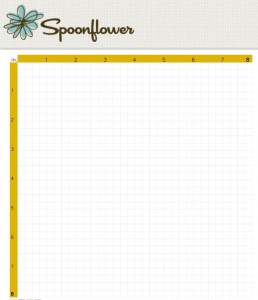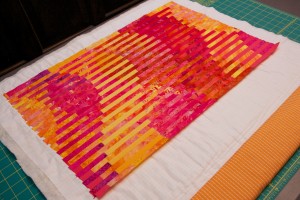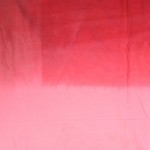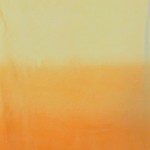 I’ve got a thing going with these Interleave quilts, and now I even have a source of fabric with (almost) precise quarter-inch grid lines for easy foundation piecing of long thin strips. After a couple of unsuccessful attempts to find commercial fabric with precise quarter-inch or half-inch stripes or checks, I gave up and created my own on spoonflower.com. You can buy it too. At $17.50/yard for basic combed cotton it is a bit pricey for fabric you will never see in your finished quilt. But if you want to piece narrow strips, this will save you hours of time. Full disclosure: if you buy it I get some royalties. All proceeds will go to support my spoonflower habit. You can see how I used the grid fabric as I pieced the quilt in the photo below. The orange fabric at the bottom is the backing fabric. It was one of the striped fabrics I auditioned and rejected for being too far off from quarter-inch stripes.
I’ve got a thing going with these Interleave quilts, and now I even have a source of fabric with (almost) precise quarter-inch grid lines for easy foundation piecing of long thin strips. After a couple of unsuccessful attempts to find commercial fabric with precise quarter-inch or half-inch stripes or checks, I gave up and created my own on spoonflower.com. You can buy it too. At $17.50/yard for basic combed cotton it is a bit pricey for fabric you will never see in your finished quilt. But if you want to piece narrow strips, this will save you hours of time. Full disclosure: if you buy it I get some royalties. All proceeds will go to support my spoonflower habit. You can see how I used the grid fabric as I pieced the quilt in the photo below. The orange fabric at the bottom is the backing fabric. It was one of the striped fabrics I auditioned and rejected for being too far off from quarter-inch stripes.
For those of you who are wondering why I care so much about precise quarter-inch stripes, quilters tend to piece their quilts with quarter-inch seam allowances. That means the stitching is always a quarter inch from the edge of the fabric. I have a special foot for my sewing machine with a guide that makes easier to do. So if you cut one-inch strips of fabric and piece them with a quarter-inch seam allowance on each side, you get a precise half-inch strip of fabric showing on the front of the quilt. This turns out to work out really well for the Interleave series because the alternating strips occupy the space of the turned under seam allowance of the adjacent strips. You can do this piecing without a foundation and just line up each strip by aligning it with the previous strip. However, I find that cutting long thin strips with perfect precision is difficult, so I am much better off if I align the strips to a pre-marked grid.
 So, armed with a couple of yards of “quarter-inch-grid” fabric, I made another Interleave quilt last week. Unlike the other quilts in this series, for this one I made two panels with different numbers of vertical fabric strips. For example, Interleave #4 and Interleave #5 both started with four vertical strips in each panel, while Interleave #3 started with five. Using the same number of strips as well as the same amplitude and frequency for the sine wave shift provides a nice, regular pattern. For Interleave #7, I went for a more chaotic approach and used five strips in one panel and four in the other. There is still an illusion of curved shapes, but these shapes are all different sizes and an interesting five-four rhythm.
So, armed with a couple of yards of “quarter-inch-grid” fabric, I made another Interleave quilt last week. Unlike the other quilts in this series, for this one I made two panels with different numbers of vertical fabric strips. For example, Interleave #4 and Interleave #5 both started with four vertical strips in each panel, while Interleave #3 started with five. Using the same number of strips as well as the same amplitude and frequency for the sine wave shift provides a nice, regular pattern. For Interleave #7, I went for a more chaotic approach and used five strips in one panel and four in the other. There is still an illusion of curved shapes, but these shapes are all different sizes and an interesting five-four rhythm.

 This quilt is made entirely from commercial batik fabrics. These are all multi-colored pinks, yellows, and oranges, which provide a rich texture. Two of the fabrics are cool ombre gradient fabrics that change color intensity from top to bottom (look for the yellow wave on the left that starts medium yellow, shifts to pale lemon, and then to cheddar; to the right is a pink wave that starts out cherry red near the top and fades to pale pink).
This quilt is made entirely from commercial batik fabrics. These are all multi-colored pinks, yellows, and oranges, which provide a rich texture. Two of the fabrics are cool ombre gradient fabrics that change color intensity from top to bottom (look for the yellow wave on the left that starts medium yellow, shifts to pale lemon, and then to cheddar; to the right is a pink wave that starts out cherry red near the top and fades to pale pink).
 With the exception of Interleave #2, I did not add any quilting beyond the quilt-as-you-go quilting that is part of the piecing process (since I piece these quilts by sewing the strips directly to a foundation fabric layered over batting, layered over backing fabric). But this time around I decided to add free motion machine quilting as well as a bit of hand embroidered stipples and french knots. The quilting ads some additional depth and also highlights some of the shapes that emerge from the chaos. Click on the photo to the left to see the quilting up close.
With the exception of Interleave #2, I did not add any quilting beyond the quilt-as-you-go quilting that is part of the piecing process (since I piece these quilts by sewing the strips directly to a foundation fabric layered over batting, layered over backing fabric). But this time around I decided to add free motion machine quilting as well as a bit of hand embroidered stipples and french knots. The quilting ads some additional depth and also highlights some of the shapes that emerge from the chaos. Click on the photo to the left to see the quilting up close.
Some of you may have observed that I haven’t said anything about Interleave #6. Quite true! Interleave #6 is still a work in progress. I started working on #7 while waiting for some Spoonflower fabric to arrive for #6. Also, #6 was commissioned as a gift, so I won’t be blogging about it until after it is presented to the recipient later this month.

